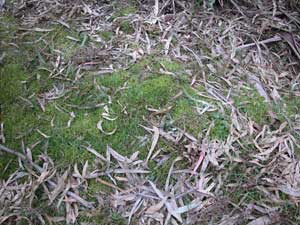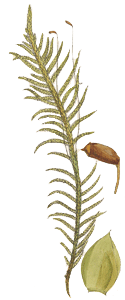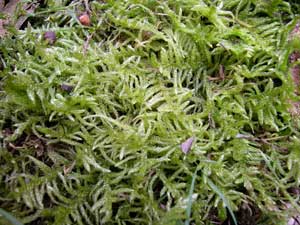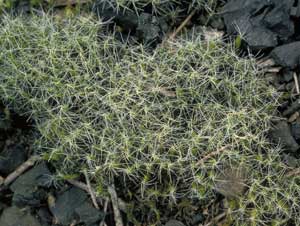|
Bryogeography
Imports and exports
Human actions have been responsible for the spread of various bryophytes. Such transport may be over long distances or relatively short distances. A trivial example of the latter occurs when you buy a potted plant, which has some bryophytes also growing in the pot, take it to your home ten kilometres away and then plant it in your garden.
Here's a possible instance over a longer distance. The moss Phascum tasmanicum (which you may also see referred to by the name Microbryum tasmanicum) is known only from Australia. The species was first described in a paper published in 1923 and the description was based on a specimen collected from the Hobart showground in 1921. So far that seems to be the only specimen that has ever been found in Tasmania. The species is found on the mainland but in a number of areas that are markedly warmer and drier than Hobart. That, and the fact that the Hobart specimen was collected at the showground, suggests that the Tasmanian specimen could have been a temporary introduction from mainland Australia. Perhaps it was carried on the feet of stock or travelled in on a person – a plausible, but not proven, hypothesis![]() .
.
The rest of this page will give some examples of bryophytes that have been transported over much longer distances. The aim is to give a few illustrative examples, rather than a detailed study of introduced species.
It is not always easy to determine if a species has been introduced by human agency. That's especially the case where a species shows a fondness for human environments, even if it can also be found in the wild. The silvery-green moss Bryum argenteum ![]() and the thallose liverwort Lunularia cruciata
and the thallose liverwort Lunularia cruciata ![]() are cosmopolitan species that are very common in urban settings. Human activity has certainly created additional areas for these species. For example, the liverwort is very much at home in glasshouses, on pot plants and on bare soil patches in well-watered and fertilized gardens. Both species undoubtedly have been introduced to some parts of the world but in others the native populations would have been able to expand with increasing urbanization.
are cosmopolitan species that are very common in urban settings. Human activity has certainly created additional areas for these species. For example, the liverwort is very much at home in glasshouses, on pot plants and on bare soil patches in well-watered and fertilized gardens. Both species undoubtedly have been introduced to some parts of the world but in others the native populations would have been able to expand with increasing urbanization.
Introduced to Australia
Rhytidiadelphus squarrosus is a common, widespread moss of the northern hemisphere. It is a creeping moss that grows on the ground and the horizontal branches create a loose carpet. In the northern hemisphere the species is found in damp grassy places and, in at least Great Britain, tolerates a wide variety of soil conditions, from chalky grassland to acidic heath. The British bryologist EV Watson noted that in Britain:
Maximal development tends to be reached – with unbroken sheets of Rhytidiadelphus squarrosus in the turf – on heavily grazed pastures, and the regularly mown 'fairways' of golf courses.
The year 1975 saw the first published record of the species in the southern hemisphere, based on a specimen collected on a golf course in Dunedin in the south island of New Zealand. In Australia the species is known only from Tasmania. The first specimen was collected in 1974 amongst moist grasses along Dundas Creek in western Tasmania. The next 20 years saw a number of other specimens gathered in the Strahan region and by 1997 the moss appeared to be well-established on golf courses at Strahan, Queenstown, Zeehan, Roseberry and Waratah. In some instances it was the dominant ground cover. In a 1997 report the Tasmanian bryologist Paddy Dalton wrote that the species is aggressive and had found a suitable niche in the wetter Tasmanian west coast area, but seemingly without penetrating native vegetation. He also noted that the species had probably achieved its spread asexually (perhaps by human-induced fragmentation) since spore production appeared to be rare, if it occurred at all, in Tasmania. In December 2006 another Australian bryologist, David Meagher, posted a comment on BRYONET, an internet bryophyte forum, in which he stated that he had found the species "...in campsites used by walkers heading into the (supposedly) pristine wilderness of World Heritage listed south-western Tasmania..."![]() .
.
Pseudoscleropodium purum is another creeping moss that grows on the ground. It has been found in New South Wales, Victoria and Tasmania up to 700 metres above sea level. It grows mostly near roads or paths. It may be native only to Europe but beyond Europe has been found in New Zealand, North America, Hawaii, St Helena, Reunion, Sri Lanka. The Canadian bryologist Wilf Schofield has commented that: " Pseudoscleropodium is often used as packing material for nursery stock in Europe, where the species is native to the flora. It is probable that this was transported out of Europe through this means." Via BRYONET, David Meagher has commented: "Two of the several endangered ecosystems in southern mainland Australia are grasslands and grassy woodlands. Pseudoscleropodium purum is a highly active invader of these ecosystems, and has been recorded in conservation reserves dedicated to their survival. Although it might appear to be confined at present to disturbed areas (mainly the sides of roads and tracks), that is I think a reflection of very limited studies. I have found it deep inside conservation reserves, clearly outcompeting the native bryophyte flora such as Thuidiopsis sparsa and Ptychomnion aciculare, and probably spread by animals (and perhaps even by botanists!)".
 |
|
On the subject of these two mosses the New Zealand bryologist Alan Fife posted the following comment on BRYONET: "Rhytidiadelphus squarrosus and Pseudoscleropodium purum are both widespread in NZ but neither successfully invade native vegetation here. Rhytidiadelphus squarrosus is widespread in the wetter parts of the South Island (where it has been recognized for c. 30 years) and Stewart Island, but it is restricted to disturbed areas such as roadsides and roughly mown areas such as picnic sites, campgrounds, and golf courses. It often occurs in abundance in disturbed, moist, and strongly insolated sites and its spread is probably encouraged by mowing. No male plants or sporophytes have been seen in N.Z. collections. This suggests that the N.Z. populations may be a single clone. Pseudoscleropodium purum is found in similar habitats: roughly mown lawns, pastures, and roadside and track verges, and it occurs on both main islands (as well as Stewart I.). It also occurs in Pinus radiata plantations, gaps in native forest, and disturbed sites in subalpine scrub"![]() .
.
Introduced elsewhere
The following is a list of bryophytes thought to have been introduced into the United Kingdom. It's taken from a book about British bryophytes that was published in 2005. Each species name is followed by the year in which a specimen of that species was first collected in the United Kingdom and then by what is thought to be the native range of the species.
Liverworts |
|
Heteroscyphus fissistipus |
1999 Australasia |
Lophocolea bispinosa |
1962 Australasia |
Lophocolea semiteres |
1955 southern hemisphere |
Lophozia herzogiana |
1986 New Zealand |
Riccia crystallina |
1950 southern hemisphere and Mediterranean |
Riccia rhenana |
1952 central Europe, south-west Asia |
Telaranea longii |
1970 Australasia? |
Telaranea murphyae |
1961 Australasia? |
Mosses |
|
Achrophyllum dentatum |
1928 Australasia |
Atrichum crispum |
1848 North America |
Campylopus introflexus |
1941 southern hemisphere |
Calyptrochaete apiculata |
1967 southern hemisphere |
Chenia leptophylla |
1964 Africa, Asia, Australasia, North and South America |
Hennediella macrophylla |
1965 South America, New Zealand |
Hennediella stanfordensis |
1958 Australasia |
Orthodontium lineare |
1910 southern hemisphere |
Scopelophila cataractae |
1967 America, Asia |
Syntrichia amplexa |
1973 North America |
|
|
I have left the table as given by the source in the Reference button, even though recent evidence would necessitate a couple of changes. That is yet again an illustration of the fact that bryogeography is a dynamic field and that current hypotheses are liable to change in the light of future research.
A description of the species Telaranea longii was first published in 1992, based on specimens collected at the Younger Botanic Garden in Argyll, Scotland and the author of that 1992 paper thought the species to be very close to Telaranea tetradactyla, a species long-known from Australasia. The same publication noted the species' occurrence at Surrey, in England, at the Royal Horticultural Society Gardens. The first specimen of the species had in fact been collected in 1970 at the Surrey site, but had been mis-identified as Telaranea murphyae. The year 2004 saw the publication of a detailed study of the Telaranea species found in Australasia. The authors of that study considered the specimens named as Telaranea longii to be identical with Telaranea tetradactyla. On the other hand, the authors could not match Telaranea murphyae with any Australasian species nor could they find any resemblance with any Neotropical or African species they knew of. Hence the original home of Telaranea murphyae is a mystery. The species is known from the Abbey Gardens, Tresco on the Isles of Scilly and from Poole in Dorset. The supposition is that the species was introduced with imported garden plants![]() .
.
The liverwort Lophozia herzogiana is included in the above list and the LOPHOZIA HERZOGIANA CASE STUDY gives the story behind that species.
The Isles of Scilly, off southwest Cornwall are in an area of the United Kingdom that has a relatively mild climate. South-west Ireland is similar. There are number of well-established gardens in those areas, dating back to about 1900, that are able to grow various Australasian plants quite well and some are renowned for their groves of the tree fern Dicksonia antarctica. Tree ferns became very popular in Europe in the later 19th century and many were imported. A number of bryophytes are suspected of having piggy-backed their way to the United Kingdom on Dicksonia trunks. The fibrous trunk provides very suitable niches for plants or propagules. In 1999 specimens of the mosses Leptotheca gaudichaudii and Calomnion complanatum were collected from a Dicksonia antarctica trunk in County Kerry, Ireland. The same year saw the discovery of the leafy liverwort Heteroscyphus fissistipus in an Irish garden and it was well-established there in both cultivated and natural woodland areas. Via an internet bryology forum the British bryologist Jonathan Sleath reported finding Leptotheca gaudichaudii at the base of a Dicksonia trunk in a Cornish garden in 2005. Epiphytic Australasian ferns have also been found growing on Dicksonia trunks in some of those gardens![]() .
.
Are introduced bryophytes a problem?
Most people would be aware of the problems that have been caused by introduced species. Two well-known examples in Australia are the destruction caused by rabbits and the reduction in coastal biodiversity where Bitou Bush has taken over.
Do introduced bryophytes cause problems? Some do, some don't. That's also the case with many other introduced plants. There are introduced species, such as Bitou Bush, that are able to reproduce easily and compete successfully. Many others lack those characteristics and so are no problem or are at most minor irritants. You see the same range in bryophytes.
There's been mention of the mosses Rhytidiadelphus squarrosus and Pseudoscleropodium purum getting a foothold in parts of the Australian bush. However, the subject of bryophyte introductions has been investigated more in the northern hemisphere than in the southern and this section will present some European examples. It has been estimated that between 20 and 30 bryophyte species have been introduced to Europe. Of those only 3 or 4 have been reported as causing serious problems.
The moss Achrophyllum dentatum has been known from the Glasgow Botanic gardens since 1928, when it was found in one of the glasshouses. It appears to be one of the species carried to Europe on Australian tree ferns. Since 1928 it has been found in the glasshouses of many other botanic gardens and 1999 appears to be the first time it was found outside a glasshouse. The location was a private garden near Truro in Cornwall and the moss was growing in a very sheltered location amongst filmy ferns. It is very unlikely that the species would be able to survive in many European locations.
By contrast the following three have been found to be aggressive invaders in both the United Kingdom and continental Europe: the leafy liverwort Lophocolea semiteres (which you will also see under the name Chiloscyphus semiteres) and the mosses Campylopus introflexus and Orthodontium lineare. All three are found naturally in Australia but Australia is not necessarily the source of the European plants.
The story of the expansion of the two mosses in Great Britain is told in the CAMPYLOPUS INTROFLEXUS AND ORTHODONTIUM LINEARE CASE STUDY. Orthodontium lineare is found in many parts of north-western Europe, as is Campylopus introflexus, but the latter had also spread to southern France, the north-western Iberian Peninsula, Italy, further into Scandinavia, Lithuania – and had even reached Iceland. Outside Europe Campylopus introflexus has been found in western North America from California to British Columbia.
Moss carpets made purely of Campylopus introflexus can be seen in many European heaths and dune grasslands. This link takes you to a PDF fact sheet that has been produced by the North European and Baltic Network on Invasive Species (NOBANIS). Here are some of the points in the fact sheet. In the Netherlands Campylopus introflexus is out-competing and displacing lichen-rich dune vegetation. There's evidence that the spread of Campylopus introflexus has contributed to the decline of the Tawny pipit (Anthus campestris) as a breeding bird in the Netherlands. The moss forms dense, dominant stands and so decreases the cover of open short grasslands, the pipit's breeding habitat. There has also been a decline in arthropods, the birds' food source, in the closed carpets of the invasive moss. Campylopus introflexus has also invaded the Danish habitats of some native pioneer moss species. In Iceland it has invaded high-temperature, species-rich geothermal areas and has affected some rare species.
Studies in both the United Kingdom and the Netherlands have concluded that the invading Lophocolea semiteres ![]() is displacing the native liverwort Lophocolea heterophylla. The introduced species has been found growing in extensive carpets in acid heaths and pine forests in Belgium and the Netherlands. Studies in those pine forests strongly suggest that Lophocolea heterophylla has the potential to dominate other liverworts on the forest floor in acid pine forests. Sporophytes have been rare, but the older leaves have been found to produce abundant vegetative propagules, up to 300 per square centimetre
is displacing the native liverwort Lophocolea heterophylla. The introduced species has been found growing in extensive carpets in acid heaths and pine forests in Belgium and the Netherlands. Studies in those pine forests strongly suggest that Lophocolea heterophylla has the potential to dominate other liverworts on the forest floor in acid pine forests. Sporophytes have been rare, but the older leaves have been found to produce abundant vegetative propagules, up to 300 per square centimetre![]() .
.
Molecular methods and introduced species
In the past it has often been impossible to pinpoint the sources of species that have been transported between continents. For example, species like Campylopus introflexus and Orthodontium lineare are widely distributed in the southern hemisphere. In some cases it is possible to argue convincingly that species have been introduced on Australian tree ferns. The high desirability of tree ferns to 19th century European gardeners generated trade in tree ferns. That certainly narrows the geographic range considerably. Still, tree ferns are found over a large area in south-eastern Australia.
Moreover, suppose an introduced species is found in several parts of Europe. Was the species introduced just once to Europe and did it then spread from the original point of introduction? Or has it been carried into Europe several times? Those questions have been hard, or even impossible, to answer. Occasionally the nature of the species helps suggest an answer. Lophocolea semiteres has separate male and female plants. In the Belgium-Netherlands region the male and female plants have shown different distributions. That suggests that the species has entered that region at least twice![]() .
.
The moss Hypopterygium tamarisci is a morphologically variable species that has a number of geographical variants. The paper mentioned in the next Reference button presents a study of three European Hypopterygium tamarisci populations – from glasshouses in the botanic gardens of Glasgow and Berlin and from the Bussaco arboretum in Portugal, the only place in Europe where any Hypopterygium grows outdoors. The authors of that paper used molecular methods and argued that their evidence indicated that the three populations originated in Australasia and that there have been two introductions – one involving the closely related Glaswegian and Berlin populations, the other the Portuguese population. The authors also argued that southern New South Wales may have been the source of the Portuguese Hypopterygium. Introduction via tree ferns is a possibility, though the introduction to the Bussaco arboretum site may have been with the various Australian trees that are planted there![]() .
.
![An Australian Government Initiative [logo]](/images/austgovt_brown_90px.gif)




